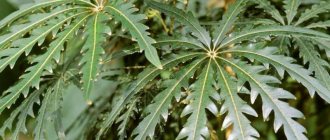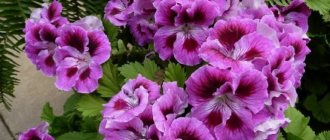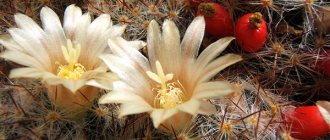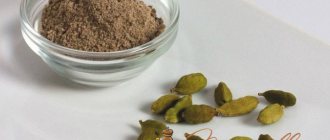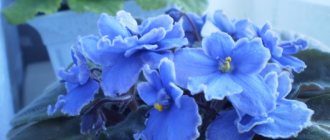Skimmia is an evergreen plant belonging to the Rutaceae family. Under natural conditions, the shrub grows in Asia and Japan. In regions with cold climates, gardeners grow it as an ornamental houseplant and are highly valued for its attractive appearance, which the plant retains throughout the year. In spring and summer, the bush is covered with beautiful inflorescences of small flowers, and in autumn and winter red berries ripen on it.
Description
Skimmia is a perennial plant with a spherical crown. The shrub most often grows no more than 1 meter in height. The leaves on short petioles are oblong, hard, slightly reminiscent of a bay leaf. The edges of the leaves sometimes have a narrow border of light green or red. They are dark green above and light green below. On the back of the leaves there are special glands that emit a pleasant aroma when the bush blooms.
Skimmia is a dioecious plant (there are male and female varieties of bushes in the genus). The inflorescences are paniculate, blooming at the ends of branched shoots. The flowers are shaped like a five-pointed star. Their color can vary: from white to purple. Flower size is 1-2 centimeters. Flowering time is March-June.
After flowering, round red drupes appear in place of the flowers. They can stay on skimmia bushes for a very long time. Sometimes it even happens that the plant is already blooming again, and last year’s dried berries are still showing off next to the flowers.
Preferences
Skimmia japonica requires partial to full shade to maintain its healthy, green, fresh appearance. Too much sun will bleach the foliage and stunt the plant's growth. Best growth will occur when the plant receives morning sun followed by afternoon dappled light. As for site selection, skimmia will grow in acidic soils that have been heavily amended with compost or other types of organic matter prior to planting.
If you can provide the right conditions, this elegant woodland creature will quickly rise to the top of your list of favorites.
Reproduction methods
Propagation of skimmia is possible in two ways:
- cuttings;
- seeds.
Cuttings are best carried out between August and February. For rooting, apical semi-lignified shoots are chosen. The length of the cuttings should be approximately 8-12 centimeters. The two bottom leaves are cut off from them. For better rooting, the branches are treated with a drug - a root formation stimulator. Then, the cuttings are placed in soil made from a mixture of peat and sand. The containers are covered with film and kept in a well-lit room.
Rooting will take approximately 15-20 days, provided that the air temperature is maintained at about 22 degrees. A sign that the plant has taken root will be the active growth of new shoots.
Skimmia seeds should be stratified before planting. To do this, they are sent to the refrigerator for 7-10 days. Then, sow the material to a depth of 1-2 cm in a mixture of peat and sand. The pots are placed in a bright place with an air temperature of 22 degrees. The first shoots appear after 2-3 weeks. Plants are transplanted into individual pots when they have formed 4 true leaves.
Diseases and pests
Improper care indoors can lead to visible damage to the plant. The first signs of disease and pests:
- white coating on the leaves: means the appearance of powdery mildew, the plant must be treated with fungicides
- black spots on leaves: means a fungal infection in the plant
- yellowing of leaves: means lack of ferrous sulfate in the soil
- cobwebs on the leaves: means the appearance of a spider mite; the first signs can be dealt with with a regular soap solution
- brown spots on the leaves: means the appearance of aphids or scale insects, requires treatment with insecticides
- softness of the stem: means the appearance of rot and excessive watering, it is necessary to drain the soil or replant the plant
Skimmia is a spectacular indoor plant that will fit perfectly into any interior. By following basic care rules, even a novice gardener can grow it.
Growing and care
Like any other indoor plant, skimmia bushes need proper regular care.
Watering
The plant can grow and develop well in a city apartment with insufficient air humidity. However, it needs regular watering. This is especially important in spring and summer. The soil in the pot should not dry out during this period, as the skimmia is actively growing and blooming. In the autumn-winter period, the frequency of watering is reduced.
Top dressing
From the beginning of spring to the onset of autumn (April - September), skimmia needs to be fertilized 2 times a month with a composition intended for flowering plants.
Lighting
Skimmia grows well in areas with plenty of light. But, you need to take into account that direct sunlight is harmful to it. They can leave burns on the leaves.
Introduction to skimmia
It all started when my husband was looking for honey plants for bees (a neighbor has three hives) and in the spring he brought home a couple of bushes of an unidentified plant: he bought it at the market, but forgot the name. I planted bushes on the plot. They began to grow, but growth occurred very slowly; by autumn the plants had added only 2-3 cm. But the leaves were beautiful, elongated, glossy, somewhat similar to the leaves of the noble laurel.
When it got colder, I took pity on the kids, transplanted them into pots and brought them onto the veranda. There they successfully overwintered with me, and in the spring I returned them to open ground, but planted them in a flowerbed, since there was a suspicion that my husband had not looked after them properly (or rather, not looked after them at all).
Kinds
There are 12 species of this shrub in total. But, in decorative floriculture, various varieties of Japanese skimmia and some others are most often used.
Skimmia japonica
In nature, a bush of this species can grow up to 1-1.5 meters. This is a dioecious plant. Based on it, breeders have developed several hybrids:
- Rubella is a male hybrid. The bush is compact, the leaves are dark green with a red edge.
- Foremanii is a female hybrid. Forms large beautiful clusters of berries after flowering.
- Fructo Alba - differs from other hybrids in the color of the berries. They are completely white.
- Magic Merlot has small leaves. Inflorescences are shaped like silver balls.
- Smits Spider. The berries on this hybrid become the color of mango by autumn.
- Fragrans are the male variety. The color of the inflorescences is white. The aroma is reminiscent of lily of the valley.
- Skimmia reevesiana (Reeves) is a self-pollinating plant. Its white inflorescences contain both male and female flowers. The berries are slightly oblong, raspberry in color.
- Brocox Rocket. On the large spherical inflorescences of this hybrid, the flowers are initially green. By autumn they gradually turn white.
Skimmia laurel
The berries of this type of shrub are colored black. The leaves are elongated, lanceolate. The inflorescences are spherical and consist of small greenish flowers. Grows in heights up to 90 cm.
Skimmia doubtful
This is a male bush. In nature it grows up to 3 meters in height. The crown can reach 1.5 meters in width. The inflorescences are spherical and cream-colored. During flowering it emits a strong pleasant smell.
Skimmia repens
The bush is cylindrical in shape. Its branches do not have leaves at the base. The dense inflorescences consist of unusual white triangular flowers. In autumn, rather large red berries ripen in their place.
Japanese skimmia - photo, description of the plant
I looked in the literature and found that my husband brought a flower Skimmia
japonica (Japanese skimmia)
. This is truly a honey plant, only very slow growing: flowering occurs in the 6-7th year. Moreover, skimmia is afraid of frost; when the temperature drops below 5 degrees Celsius, the flower begins to ache.
In spring and summer, during the period of active vegetative growth, the bush is placed outside or on a well-lit terrace; lack of oxygen can also cause plant diseases.
Japanese skimmia (also called garden) from the Rutaceae family in our climate is best grown as a container plant to be brought into the house or a heated greenhouse for the winter. After this information, my husband lost interest in this plant, as he realized that it would not be possible to grow it on a large scale (for bees). And I admired the beautiful pictures of the skimmia and realized that I was unlikely to give up such beauty.
Small star-shaped female and male flowers are collected on different plants in apical panicle-shaped inflorescences - racemes. Flowering begins in March or April. The upper part of the leaves is dark green, the lower part is light gray. By the beginning of autumn, glossy red berries, collected in clusters, form on the bush. The berries are fleshy and contain one small seed. They are not eaten because of the toxic substance skimminin they contain.
How to care at home
In order for the plant to develop properly and not lose its attractiveness, all recommendations for growing skimmia should be followed. Basic garden care for shrubs consists of:
- Choosing the right place
- Compliance with the light regime
- Maintaining the required air and soil humidity
- Bush formation
- Feeding with nutrients
- Pest control treatment
Skimmia (skimmia) loves bright rooms. But the light must be diffused. Direct sunlight causes leaf burns. The best place in the house is considered to be the south-eastern and eastern sides. It is advisable to place the flower pot in special stands in front of the window.
Temperature conditions. The ambient temperature during cultivation should not exceed 24 degrees.
The minimum value for the spring, summer and autumn seasons is 17 degrees. In too hot conditions, the shrub sheds a large amount of foliage. The leaves are not restored afterwards. To activate flowering and the growth of new shoots, it is recommended to create dormant conditions for the plant during the winter season. To do this, you need to place the skimmia in a room with a temperature no higher than 12 degrees.
Humidity. This crop loves high air humidity. Therefore, during cultivation it is necessary to carry out additional spraying. It is carried out 2 times a week, you need to use warm, settled water.
The photo shows a colorful skimmia in a flower garden
Watering. Skimmia is a moisture-loving plant, so the earthen clod should not be allowed to dry out completely.
In the spring-autumn season. The flower is watered quite generously three times a week. In winter, one watering every 5-6 days is enough.
To form a bush, two types of pruning are necessary. Sanitation is carried out in early spring. At this time, all damaged, dried and thickening branches that thicken the crown are removed. Formative pruning is performed after flowering or fruiting. To do this, the bush is shaped by cutting off the tops of the shoots. This pruning stimulates the growth of side branches, which gives the bush density and density.
Fertilizing skimmia is necessary for proper nutrition of the plant. Feeding is carried out twice a month with an interval of two weeks. To enrich the soil, it is recommended to use complex mixtures or alternate organic and mineral products. The best fertilizer is considered to be special nutrient mixtures for rhododendrons, which can be purchased at garden stores.
Skimmia is quite resistant to various diseases and pests, but sometimes it is affected by aphids, spider mites and scale insects. To prevent infection, it is necessary to follow the rules of agricultural technology and carry out preventive treatment with special means.
It is recommended to keep it in a separate room for several days and make sure it is healthy.
If signs of pests appear on the leaves, the plant must be treated urgently. The following drugs are most effective: Actellik, Fitoferm, Fufan, Bicol. In addition, it is permissible to use natural remedies such as a suspension of laundry soap, spraying with chamomile decoction and an alcohol solution.
Skimia photo in open ground
If skimmia is grown away from other plants, you can get rid of pests by thoroughly washing the leaves and twigs in the shower.
It is not recommended to use pesticides when controlling pests. After all, they simultaneously destroy beneficial insects, which prevent the appearance of pests.
Initially, it may seem that skimmia requires special attention. But in fact, all care activities are standard for many flower crops.
Therefore, even a novice gardener can grow any type of this crop.
Expert opinion
Yulia Yurievna
I have a large garden and vegetable garden, several greenhouses. I love modern methods of cultivating plants and mulching the soil, and I share my experience.
Ask a Question
In the summer, especially on southern windows, the sun can really be so strong that burns will appear on the crown of the skimmia plant. To avoid this and ensure good care, you can create a protective screen. To do this, you need to fix a not too thick piece of white paper on the glass. If the windows are wide, it is convenient to use parchment.
Also, this method will help protect the skimmia from overheating. If in the summer heat you notice that the plant looks lethargic, you should move it to a cooler place. You can additionally spray the plant to restore water balance. Water procedures should not be carried out; if the bush is in the sun, burns may occur.
The described culture, especially Japanese skimia, loves moisture very much. Watering is required frequent and abundant. This means that it is very important to take care of drainage and moisture permeability of the soil. After all, stagnation of water can lead to illness. You can put sawdust on the bottom of the pot. This will make the pot less heavy than using pebbles for drainage.
If pests appear on the plant, you need to quarantine it as soon as possible, separating it from other indoor crops. Afterwards, thoroughly wash the area where the affected plant was located. We recommend ironing the curtains additionally.
If aphids are noticed, it is important to make sure that there are no ants in the room, because they are the ones who carry it. Sometimes pests are green in color and are located on the back of the leaf, so they are not easy to notice right away. Other characteristic signs include a sticky coating and wilting of the plant.
In addition to chemicals, an effective way to combat this insect is spraying with a solution of boric acid. This product is also a top dressing, which improves flowering.
If you decide to bathe a flower in the shower, it is important to cover the soil with something or keep the pot tilted at all times so that water does not flow into it. Sucking insects very often carry infections, so if, in addition to attacking pests, you also flood the skimmia, it can get sick.
If the leaves begin to wither, dry out, fall off, and a thin white cobweb is noticed on them, the plant is affected by a mite. It is not easy to get rid of it due to the tenacity of the pest larvae. For this reason, it is important to choose a drug that destroys not only adults, but also eggs.
You can start with a product that sterilizes female ticks, and then use Neoron. It is important to carry out 2-3 sprays at the intervals specified in the instructions.
Scale insects look like small tubercles on the crown. If there are only a few pests, you can try to clean them off with a brush or cotton swab soaked in soap or alcohol. The appearance of such pests is often accompanied by the development of sooty fungus.
It must be washed off, because the pores of the plant become clogged, which interferes with the breathing process. The problem will disappear when you manage to get rid of the insects.
Skimmia prefers to grow indoors; it does not tolerate cold. Direct sunlight also affects it negatively, so it is better to keep the plant in slight shade in a temperate climate, otherwise wounds in the form of burns will appear on the leaves.
Soil moisture is of primary importance with the addition of drainage required. Peat soil, coarse sand or loam are ideal for wood.
Rules of care:
- Choose a place where there is no direct rays of the sun, but not complete shade;
- The air should be cool;
- Protect from strong drafts;
- Water frequently but moderately;
- The liquid for irrigation should be settled (12-15 hours), without chlorine;
- Wipe off dust from leaves;
- Ventilate the room;
- Feed with complexes for flowering plants in April and September;
- Trim dried shoots and flowers.
The shrub tolerates pruning well and does not allow it to grow too much. Skimmia grows better at home, but when the warm season arrives, it is often taken out into the fresh air.
Soil and fertilizer
Skimmia is an acedophilic plant. This means that the soil reaction for it should have a slightly acidic or acidic reaction. If the acidity decreases, then over time interveinal chlorosis appears on the leaves.
In addition, the soil must be nutritious, medium-heavy, permeable to water and air. It is recommended to replant young skimmy plants once every two years in the spring.
More mature specimens can grow in one tub for a long time if the top layer of soil is updated.
Prepare the following mixture for planting:
- turf land (2 parts);
- peat (2 parts);
- sand (1 part);
- perlite (1 part).
Fertilize skimmia once every three to four weeks with universal liquid organic fertilizers, which are applied along with watering. The concentration is half that recommended by the manufacturer.

